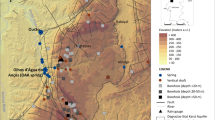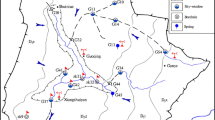Abstract
Understanding how the discharge-rate and the hydraulic gradient of a karst aquifer varies in response to rainfall events is important for the efficient management of water resources in these aquifers. The relationship between discharge and hydraulic gradient is related to aquifer properties such as the physical characteristics of the karstic matrix, hydraulic conductivity and the extent to which water is exchanged between conduits and the matrix. In this study, discharge and hydraulic gradient data were monitored at 4-h intervals for 476 continuous days in the Zhaidi karst aquifer located in Guilin, Guangxi Province, China. These data showed that the relationship between flow rate and hydraulic gradient in the aquifer became increasing non-linear with increasing flow rates. After analyzing the time series data, a hydrodynamic threshold between quickflow- and baseflow conditions was found to take place at a discharge rate of 0.80 m3/s. The linear law and nonlinear equations were obtained between discharge and hydraulic gradient which reflected the flow mechanism of groundwater flow in this karst aquifer.








Similar content being viewed by others
References
Angelini P (1997) Correlation and spectral analysis of two hydrogeological systems in central Italy. Hydrol Sci J 42(3):425–438. https://doi.org/10.1080/02626669709492038
Atkinson TC (1977) Diffuse flow and conduit flow in limetone terrain in the Mendip hills, Somerset (Great Britain). J Hydrol 35:93–110
Bonacci O (1993) Karst springs hydrographs as indicators of karst aquifers[J]. Hydrol Sci J 38(1):51–62
Darcy H (1856) Les fontaines publiques de la ville de Dijon: exposition et application. Victor Dalmont, Paris
Dewaide L, Bonniver I, Rochez G, Hallet V (2016) Solute transport in heterogeneous karst systems: dimensioning and estimation of the transport parameters via multi-sampling tracer-tests modelling using the OTIS (One-dimensional Transport with Inflow and Storage) Program. J Hydrol 534:567–578
DiFrenna VJ, Price RM, Savabi MR (2008) Identification of a hydrodynamic threshold in karst rocks from the Biscayne Aquifer, south Florida, USA[J]. Hydrogeol J 16(1):31
Fiorillo F (2014) The recession of spring hydrographs, focused on karst aquifers. Water Resour Manage 28:1781–1805. https://doi.org/10.1007/s11269-014-0597
Fiorillo F, Doglioni A (2010) The relation between karst spring discharge and rainfall by cross-correlation analysis (Campania, southern Italy). Hydrogeol J 18:1881–1895. https://doi.org/10.1007/s10040-010-0666-1
Ghasemizadeh R, Hellweger F, Butscher C, Padilla I, Vesper D, Field M, Alshawabkeh A (2012) Review: groundwater flow and transport modeling of karst aquifers, with particular reference to the North Coast Limestone aquifer system of Puerto Rico. Hydrogeol J 20(8):1441–1461
Huihai. L, Birkholzer J (2012) On the relationship between water flow and hydraulic gradient for unsaturated and saturated clay. J Hydrol 475:242–247
Kovacs A, Perrochet P, Darabos E, Lenart L, Szucs P (2015) Well hydrograph analysis for the characterization of flow dynamics and conduit network geometry in a karst aquifer, Bukk Mountains, Hungary. J Hydrol 530:484–499
Lauber U, Goldscheider N (2014) Use of artificial and natural tracers to access groundwater transit-time distribution and flow systems in a high-alpine karst system (Wetterstein Mountains, Germany). Hydrogeol J. https://doi.org/10.1007/s10040-014-1173-6
Lianxing Yi R, Xia J, Tang D, Lu Z, Wang H, Lu LZ (2014) Karst conduit hydro-gradient nonlinear variation feature study: case study of Zhaidi karst underground river. Environ Earth Sci 74(2):1071–1078
Lihong L, Xunhong C, Guangquan X, Longcang S (2011) Use of hydrologic time-series data for identification of hydrodynamic function and behavior in a karstic water system in China. Hydrogeol J 19:1577–1585. https://doi.org/10.1007/s10040-011-0774-6
Malik P, Vojtkova S (2012) Use of recession-curve analysis for estimation of karstification degree and its application in assessing overflow/underflow conditions in closely spaced karstic springs. Environ Earth Sci 65:2245–2257. https://doi.org/10.1007/s12665-012-1596-0
Mayaud C, Wagner T, Benischke R, Birk S (2014) Single event time series analysis in a binary karst catchment evaluated using a groundwater model (Lurbach system, Austria). J Hydrol 511:628–639
Nassery HR, Alijani F, Nakhaei M (2013) The comparison of hydrodynamic characteristics of karst aquifers: application on two karst formations in Zagros (Asmari and Ilan-Sarvak), southwest Iran. Arab J Geosci 10:1007–1017
Perrin J, Luetscher M (2008) Inference of the structure of karst conduits using quantitative tracer tests and geological information: example of the Swiss Jura. Hydrogeol J 16:951–967. https://doi.org/10.1007/s10040-008-0281-6
Ranjith PG, Viete DR (2011) Applicability of the ‘cubic law’ for non-Darcian fracture flow. J Pet Sci Eng 78:321–327
Shoemaker WB, Kuniansky EL, Birk S, Bauer S, Swain ED (2008) Documentation of a conduit flow process (CFP) for MODFLOW-2005, Book 6, Chapter A24. U.S. Geological Survey Techniques and Methods, Virginia
White WB, White EL (2005) Ground water flow distribution between matrix, fractures, and conduits: constraints on modeling. Speleogenesis Evol Karst Aquifers 3(2):1–6
Worthington SRH, Soley RWN (2017) Identifying turbulent flow in carbonate aquifers. J Hydrol 552:70–80
Acknowledgements
We thank National Natural Science Foundation of China (no. 41502252), CGS Research Fund (no. JYYWF20180402) and China Geological Survey (no. DD20160300) for supporting this study. We also thank all anonymous reviewers for their helpful suggestions.
Author information
Authors and Affiliations
Corresponding author
Electronic supplementary material
Below is the link to the electronic supplementary material.
Rights and permissions
About this article
Cite this article
Zhao, L., Yang, Y., Xia, R. et al. Evaluation of a hydrodynamic threshold in the Zhaidi karst aquifer (Guangxi Province, China). Environ Earth Sci 77, 424 (2018). https://doi.org/10.1007/s12665-018-7599-8
Received:
Accepted:
Published:
DOI: https://doi.org/10.1007/s12665-018-7599-8




